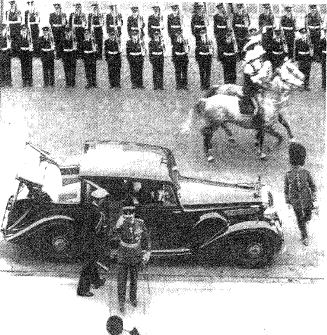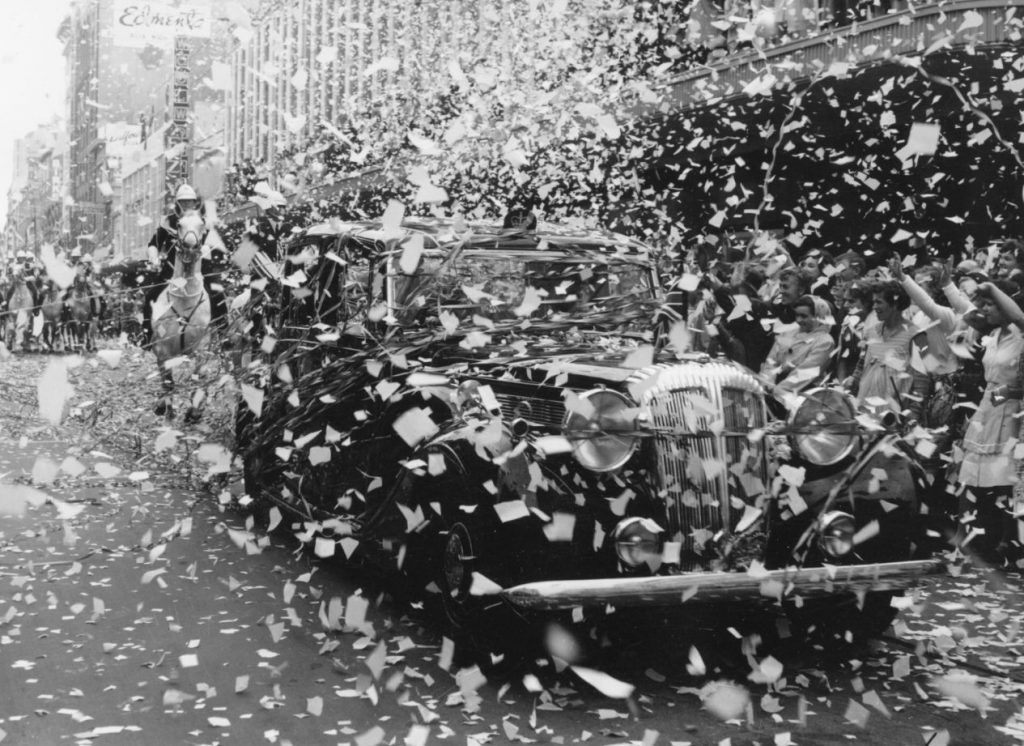by Laura Breen on 17 July, 2012

In researching our Daimler’s lengthy past, I was not the least bit surprised to discover that the car’s ceremonial duties did not cease with the completion of Queen Elizabeth’s royal tour in 1954. After all, in the aftermath of the royal visit, what else could be done with such a cumbersome and imposing motor car?
By now six years old, the Daimlers were certainly the least fashionable mode of transport in the government car pool. Most were dispersed to various auction houses, and some survive to this day in one form or another. Luckily for our car, Sir Robert George, the Governor of South Australia, wrote to the Premier, Thomas Playford, to ask whether he might acquire one of the Daimlers to replace his own ‘worn out’ ceremonial vehicle.
In a series of correspondence now archived at the State Records of South Australia, Playford and Prime Minister Robert Menzies agreed on a price and for the ‘first class’ vehicle to be delivered in Adelaide in October 1954. At that stage, our Daimler had travelled only 16,579 miles.
The Governor seemed quite taken with his new transportation, describing it as ‘a splendid acquisition to the Vice Regal Establishment, and one which we shall be proud to use in our duties to the State’.
The Daimler was indeed used for various state vice regal occasions including the opening of state Parliament in 1957, and the Governor’s farewell tour of Adelaide in 1960.

Three years later, in 1963, its future looked doubtful. Although meticulously maintained since its manufacture in 1948, an employee of the state government’s Motor Garage now described it as ‘on its last [..] wheels’, having travelled 47,635 miles.
The foreman also recounted a litany of complications including excessive oil consumption, an ineffective chassis lubricating system, the unserviceable nature of the canopy switch, and excessive squeaks and rattles as the internal bodywork timbers deteriorated.
Most telling however is his ominous verdict: ‘Not only is it necessary for continuous maintenance to keep the vehicle in a satisfactory condition for the purpose for which it exists, but difficulty has been experienced in procuring spare parts and I am now informed that certain steering components are not available in Australia or elsewhere. This factor alone makes it obvious that the early disposal of this unit is desirable’.
Harsh words. Looking at the wider social context however, it seems that, even in these few short years, the prestige of the Daimler marque had all but vanished. During the austere post-war 1940s and early 1950s, the fate of the company was assured by its continued production of bulky petrol-guzzlers aimed at the luxury market – a clear contrast with the moderately-sized and cheaply priced vehicles produced by other manufacturers.
The finger of blame has also been pointed at Lady Norah Docker, the wife of Daimler’s Manager Director, Bernard Docker. Lady Docker was snarkily described in the Melbourne Argus of 2 June 1956 as ‘the pub-keeper’s daughter who married three millionaires in succession to become England’s most exciting, explosive and unashamed rich woman’. Her questionable taste resulted in a series of ostentatious and cheerfully vulgar showcars between 1951 and 1956, when her husband was unfortunately sacked from the board.
According to the Adelaide Mail of 20 October 1951, Lady Docker’s first and most notorious Daimler featured ‘Twenty ounces of 18 carat goldplate [which] covered the headlights, door handles, radiator grille, window edges, wheel discs and bumpers.
The coachwork was in black, studded with several thousand miniature gold stars, each painted on individually. The upholstery was of carriage silk brocade in gold.
The cabinet work, of Australian camphor wood, included a cocktail cabinet, and a picnic outfit.’ It must have been a sight. Unsurprisingly, both royalty and the car-buying public remained unimpressed by the Daimler Company’s turn for the absurd, and by 1960, the marque had been subsumed by Jaguar. It disappeared in all but name.
Our Daimler also fades from view, and without a famous passenger becomes harder to track in the historical record. In April 1964, it was sold for £405 to a local car dealer. It passed through two further South Australian owners in the late 1960s and early 1970s, before being purchased by the Museum from a private collector in 2009.
Does anyone know whether Lady Docker’s gold-plated Daimler still survives?
I was visiting relatives in Roma, Qld. in about 1973 or 1974 when I had occasion to call at the Ford dealer there. While I was there I noticed a Daimler the same as your project car in their rear storage area. On enquiring I was told that it was one of the two identical cars used in the Coronation visit. The car had belonged to a Doctor Smith who was the father of some ten or twelve children and the vehicle had been used by his spouse to drive the children around. The car was still in a reasonable condition but had a cracked engine block. I was advised that, if I wanted the vehicle, I was quite at liberty to take same away. Regretfully I decided my financial position at the time would not allow for the repairs required. Anyway, I hope this little bit of history may be of use to you.
Hello Ted, and thanks so much for getting in touch.
You’ll be pleased to hear that, as far as we are aware, this Queensland Daimler also survives to this day in private hands. Both of the landaulette types used in 1954 seem to have been particularly hard-wearing…or just lucky! I love the thought of the car being used to ferry twelve children around – they are certainly spacious enough. Thanks again for your interest.
I believe as a child I had a ride in one of the “royal Daimlers”. My great uncles were Edward and Vivian O’Brien who founded the O’Brien Publicity Company, the publishers of the “Pink Pages”. I believe that one of them purchased one of the Daimlers used during the royal visit. At around the age of 10 (1955) I can remember being picked up with my mother from our home by this very large and impressive black car with a chauffeur, to be driven to some family event. I was told that the car had been one of the royal visit fleet.
Hello Warwick, and thanks for getting in touch with your memory of riding in one of the royal Daimlers. Could I ask which state you lived in as a child? Our car was sold to the Governor of South Australia immediately after the Royal Tour, and so it is possible that the Daimler you mention was one of the other three cars included in the fleet. It must have been quite a treat!